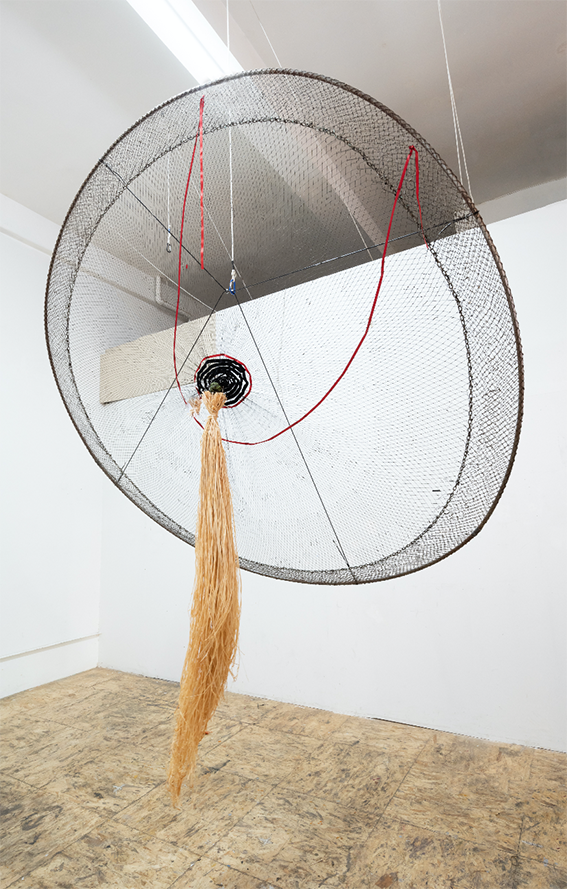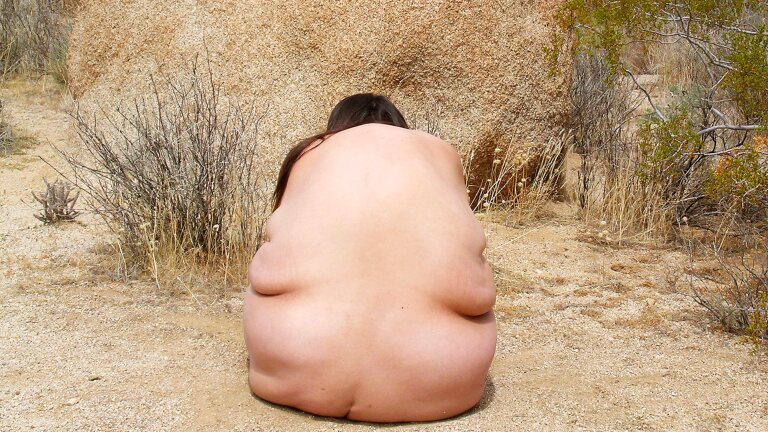Power in Care: Carolina Caycedo Maps the Long History of Feminine Environmental Work

On York Boulevard in Highland Park, a busy main street, you might miss them at first. But when you slow down from your walk, or stop at the red light, you'll see them clearly — larger than life. At Oxy Arts, Carolina Caycedo has staged photographs of women involved in environmental feminism. Some of them hold up signs, others their fists. And if you stop to take in the installation at the right moment, you can hear them speak and learn more about their stories. The audio runs every ten minutes, and passersby can take in the piece without having to enter the gallery space.
In fact, "Care Report" was installed with that in mind. As Oxy Arts' 2020-21 Wanlass Artist-in-Residence, Caycedo knew she would have to work with certain limitations for this show, which explores the idea of care as it relates to women and femmes in environmental movements. The show is a multi-layered exhibition that includes an outdoor mural and other pieces meant to be seen from the sidewalk.

The brightly colored mural, "In Yarrow We Trust," installed on the exterior corner of the Oxy Arts building along Armadale Ave., was created with student collaborators Chala Escobar and Claire Lau. It portrays a healing plant which has been said to help with menstrual pain. A series of colorful banners installed along the entryway of the main gallery entrance represent a range of issues, from the protests against the environmental effects of gold mines in Amulsar, Armenia to Argentina's struggle to get abortion legalized, which became official late last year. Taken together, the pieces in "Care Report" highlight a clear link between these issues.

"The root of the exhibition is understanding women's care for a place and for their family and for others as really the root of environmental action," Caycedo tells "Southland Sessions." "It's because a woman cares for where they were born … she cares for that place, because she is part of that place. That's what moves her to engage, then, in stronger environmental activism, hold the frontlines, put herself at risk."
The collage, which you can view from York boulevard through a large window in the Oxy Arts space, captures women from around the world, including Southern California. It depicts the Mothers of East L.A., who protested the building of a state prison in 1986 and plans for a hazardous waste incinerator in 1989.

Lideres Campesinas, a California-based farm working women organization tracing its roots back to 1988, is also included in the collage. The organization serves "as a liaison between farmworker communities and public agencies, academia and service providers," according to its website, and has written letters to the Governor advocating for better health education regarding COVID-19, specific shopping hours at grocery stores for workers and other concerns.
Caycedo first connected with the group during the opening of her 2019 exhibition at the Palm Springs Art Museum titled "Birdsongs String Bulletin (Periódico de Cordel)." Visitors to the space were encouraged to add "pieces of environmental memory" to the installation, Caycedo says. While speaking with the founding members of Lideres Campesinas at the exhibition's opening, Caycedo says she learned about how they sometimes use the cloths they cover their faces with in the field to draw or write messages about the issues they hope to raise awareness about, like the use of agro-toxics.
For a group exhibition at Los Angeles Contemporary Exhibitions (LACE) titled "Unraveling Collective Forms," Caycedo created a series of portraits of women environmentalists. There, she met the East Yard Communities for Environmental Justice (EYCEJ). Established in 2001 by people residing in Commerce and East Los Angeles, EYCEJ focuses on affecting change on a policy level by providing workshops and training to help under-represented communities' concerns be heard.
Caycedo says that as part of the exhibition programming, members of the EYCEJ shared "their environmental memories and experiences as organizers, and as victims and survivors of environmental injustice in the Long Beach area and the Vernon area." Their stories pointed at a larger "environmental memory," which spans many years. The group, for example, campaigned against an expansion of the 710 freeway, proposed in 2001, because of the already-high levels of pollution it has caused. "Communities near the freeway have suffered "generational impacts due to pollution," the organization explains on its website — something that was captured through the exhibition and its related programming.
"We had intergenerational testimonies," said Caycedo of the LACE exhibition programming. "There was somebody in their 60s speaking about how they have been in the organization for a couple of decades. And now one of their daughters who at that point was 19 or [in her] early 20s [was] also speaking about how she's inherited that struggle."
Caycedo has made an ongoing practice of bringing organizations that fight for environmental justice into art spaces. During another residency — at Heart of Los Angeles (HOLA) Visual Arts with her partner David de Rozas — Caycedo invited the organizations Youth in Action! Group to speak with students. Caycedo explained she was interested in "finding and opening spaces" for organizations "to share with the public the amazing work they do."
And her focus has remained, especially, on the women and femmes that lead these organizations, movements and efforts. "Care Report" also includes the sculpture "Milk," — installed in another section of the gallery, also seen from the sidewalk — which references breasts and nurturing. "That's the power that as women, feminized bodies, femmes who are in the front line — that's the power we have. We nurture physically with our milk, for those who can give milk, but also by holding the front lines," Caycedo explains in a video tour of the show.

In this way, "Care Report" as a title for the exhibition and the collage, then, brings this message full circle.
"There's this underlying current of women's rights: the possibility of caring for ourselves and for our kids and for our body, understanding that the territories or place where we live as an extension of our body," said Caycedo. "What is done to that place — be it a river, a mountain, the headwaters of the river or a forest — is as hurtful and damaging as if that violence was inflicted on our own bodies."
Listening to the audio segment of the collage — which was previously installed in a different iteration in Poland's Muzeum Sztuki where visitors could see it indoors — against the backdrop of a main city street adds another layer. Viewers might think about the exhaust fumes of passing cars and the settling smog that's become a trademark of Los Angeles while learning more about women fighting for their communities and the environment.
"Violence against nature is held by the same patriarchal principles that the violence that's inflicted to women, to femmes, to trans bodies, to feminized bodies," Caycedo said. "That rape culture that we live in upholds both the violence against nature and the violence against women and femme bodies."
Care Report is on view through April 4.






